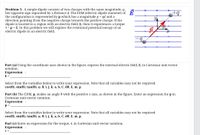Question
can you please ans (k) & ( l)?

Transcribed Image Text:Part (k) An electric dipole with an EDM, p, in a region of uniform electric field, E, directed from left to right is shown for
several orientations where the angle between the directions of the field and the EDM takes the values 0°, 45°, 90°, 180°, 225°,
270° and 315°. Select the image or images corresponding to maximum potential energy.
SchematicSelect :
E
Part (1) What is the maximum value of U(0) consistent with the choice of the arbitrary additive constant made in earlier
steps?
Expression :
Umax =
Select from the variables below to write your expression. Note that all variables may not be required.
cos(0), sin(0), tan(0), q, 0, î, ĵ, k, a, b, C, d0, E, m, p

Transcribed Image Text:Problem 5: A simple dipole consists of two charges with the same magnitude, q,
but opposite sign separated by a distance d. The EDM (electric dipole moment) of E
the configuration is represented by p which has a magnitude p = qd and a
direction pointing from the negative charge towards the positive charge. If the
dipole is located in a region with an electric field, E, then it experiences a torque
T= p x E. In this problem we will explore the rotational potential energy of an
electric dipole in an electric field.
Part (a) Using the coordinate axes shown in the figure, express the external electric field, E, in Cartesian unit-vector
notation.
Expression :
E =
Select from the variables below to write your expression. Note that all variables may not be required.
cos(0), sin(0), tan(0), q, 0, î, ĵ, k, a, b, C, d0, E, m, p
Part (b) The EDM, p, makes an angle 0 with the positive x axis, as shown in the figure. Enter an expression for p in
Cartesian unit-vector notation.
Expression :
p =
Select from the variables below to write your expression. Note that all variables may not be required.
cos(0), sin(0), tan(0), q, 0, î, ĵ, k, a, b, C, d0, E, m, p
Part (c) Enter an expression for the torque, t, in Cartesian unit-vector notation.
Expression :
Expert Solution
This question has been solved!
Explore an expertly crafted, step-by-step solution for a thorough understanding of key concepts.
This is a popular solution
Trending nowThis is a popular solution!
Step by stepSolved in 2 steps with 2 images

Knowledge Booster
Similar questions
arrow_back_ios
arrow_forward_ios